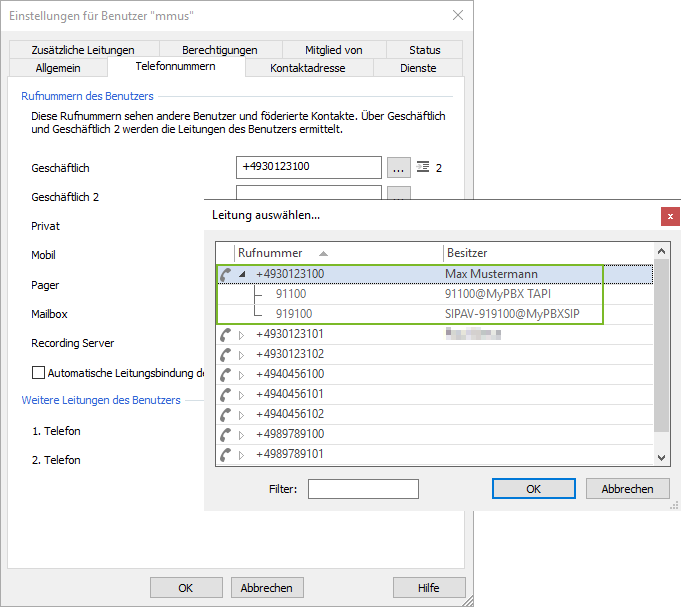Practical example 5: Combination of location prefix and additional SIP prefix
January 2024
Basics and further practical examples: Location settings – advanced configuration
The practical example described here shows a possible approach, is for illustrative purposes only and is not a ready-made solution that can be adopted 1-to-1 in the customer environment.
Challenge
Combination of location prefix for external extension and additional second prefix for SIP lines
In this scenario, the two variants from Practical example 2 and Practical example 4 should be combined, i.e. the external extension should be extended internally by a location-dependent prefix and a second prefix should also be added to the SIP lines.
A location-dependent prefix is added internally to the external extension.
In this example:
- Berlin 91 (+ extension)
- Hamburg 92 (+ extension)
- Munich 93 (+ extension)
In addition, a second prefix (9 in this example) should be added to the SIP lines.
The subscriber in Hamburg with extension 158 therefore has the following internal numbers:
- TAPI line: 92 158
- SIP line: 92 9 158
In this scenario, it is assumed that the telephone system always expects the call on the "main extension" and also signals the call on the SIP line.
For example, if 91150 is called, 919150 will also ring.
Location | Phone number | DuWa ext. from | DuWa ext. to | DuWa int. from | DuWa int. to |
|---|---|---|---|---|---|
Berlin-TAPI | +49 30 123 - 0 | 100 | 999 | 91100 | 91999 |
Berlin-SIP | +49 30 123 - 0 | 100 | 999 | 919100 | 919999 |
Hamburg-TAPI | +49 40 456 - 0 | 100 | 999 | 92100 | 92999 |
Hamburg-SIP | +49 40 456 - 0 | 100 | 999 | 929100 | 929999 |
Munich-TAPI | +49 89 789 - 0 | 100 | 999 | 93100 | 93999 |
Munich-SIP | +49 89 789 - 0 | 500 | 699 | 939100 | 939999 |
It may be possible to implement the configuration across 3 locations in the UCServer.
However, as SIP and TAPI lines sometimes require different formatting rules (e.g. TAPI with outside line access and SIP without outside line access), it may be necessary to create a separate location in the UCServer for each of the SIP and TAPI lines – in this case, 6 locations would then be required in the UCServer.
In this example, the configuration is carried out via 3 locations - TAPI and SIP lines are therefore combined in one location.
Procedure/implementation
Basic configuration of the locations
First, the individual locations are all configured according to the external numbering plan under:
UCServer Administration – General – Location name – Country/Region – Area code – Advanced settings and
UCServer administration – Telephone system
Example screenshots for the locations: UCServer Administration – General – Location name – Country/Region – Area code – Advanced settings
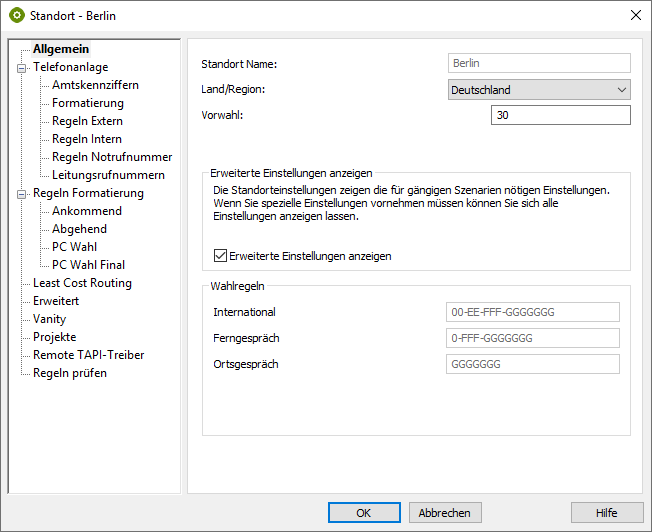
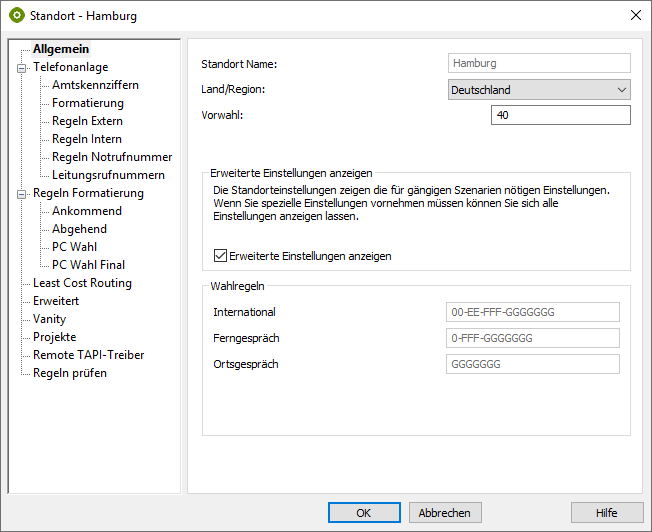
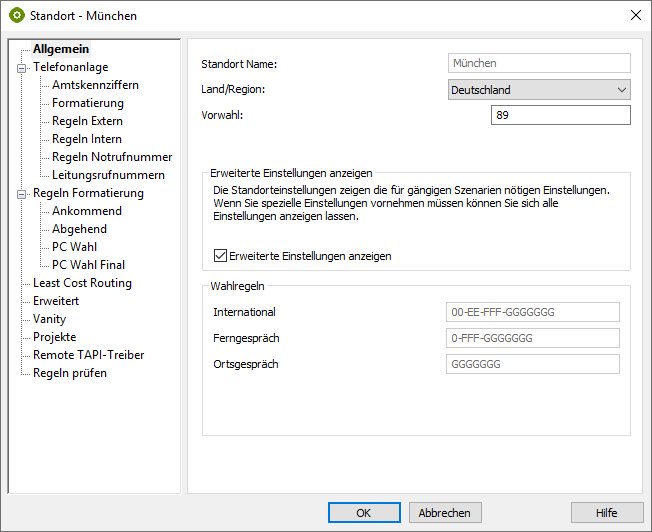
Example screenshots for the locations: UCServer administration – Telephone system – Location used telephone system – Exchange line access – Type – System number – Extension number range
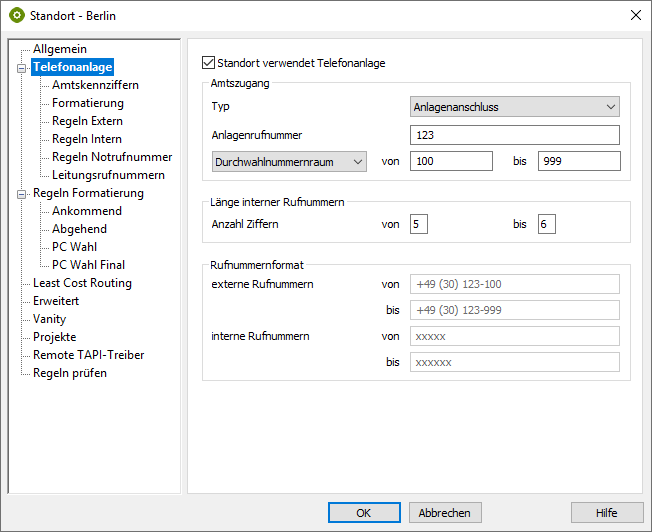
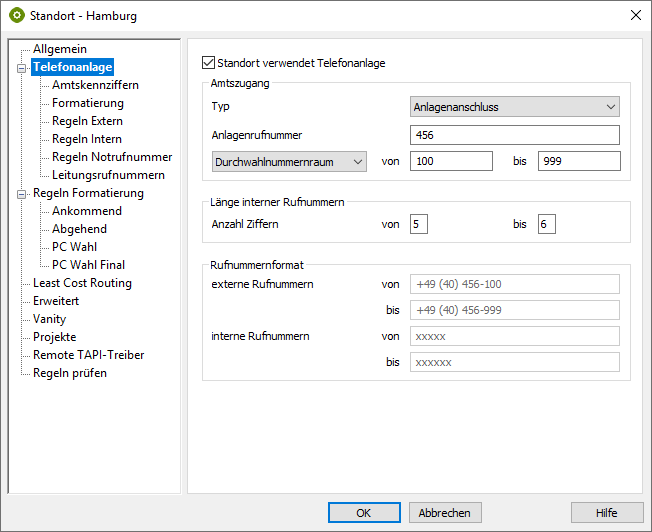
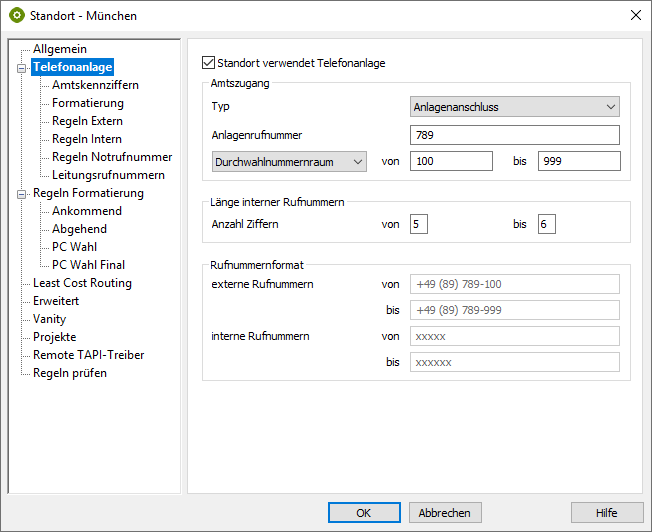
The locations are all configured in advance according to the external numbering plan. The only special feature here is the length of internal phone numbers. As the TAPI lines are prefixed with 91, 92 or 93 (e.g. 100 → 91100) and the SIP lines with 919, 929 or 939 (e.g. 100 → 919100), the length of the internal numbers in this example is 5-6 digits.
Recognition of internal phone numbers
The regular expressions for recognizing internal telephone numbers are now entered under internal rules for the telephone system in the UCServer administration.
Example screenshots: UCServer administration – Location – Telephone system – Internal rules – Regular expression
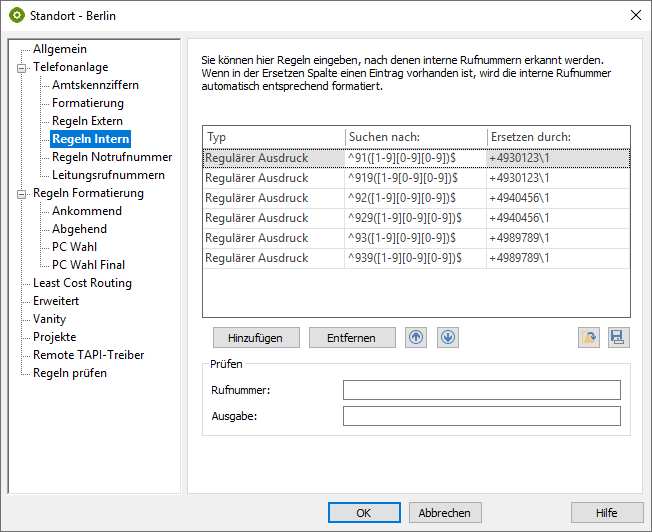
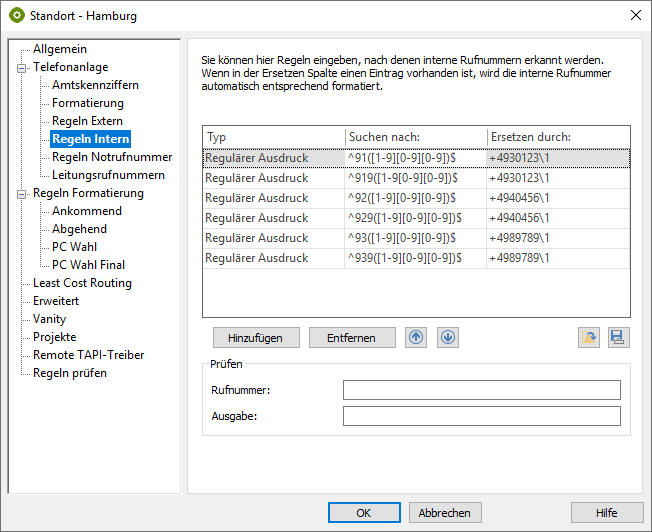
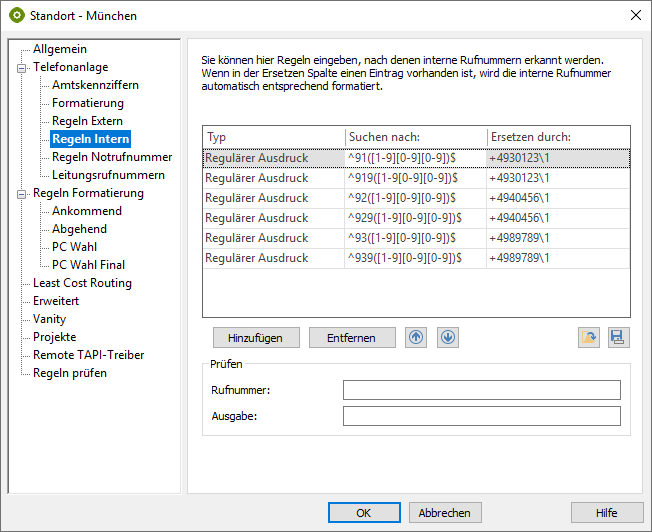



The regular expressions under "Telephone system >> Internal rules" are intended to ensure that the correct E.164 number is determined from the respective internal number. E.g. for the display in the call window.
| Type | Search for: | Replace with: | Comments |
|---|---|---|---|
| Regular expression | ^91([1-9][0-9][0-9])$ | +4930123\1 | RegEx for formatting the phone numbers of the TAPI lines from Berlin |
| Regular expression | ^919([1-9][0-9][0-9])$ | +4930123\1 | RegEx for formatting the phone numbers from SIP lines Berlin |
| Regular expression | ^92([1-9][0-9][0-9])$ | +4940456\1 | RegEx for formatting phone numbers from TAPI lines Hamburg |
| Regular expression | ^929([1-9][0-9][0-9])$ | +4940456\1 | RegEx for formatting phone numbers from SIP lines Hamburg |
| Regular expression | ^93([1-9][0-9][0-9])$ | +4989789\1 | RegEx for formatting phone numbers from TAPI lines Munich |
| Regular expression | ^939([1-9][0-9][0-9])$ | +4989789\1 | RegEx for formatting phone numbers from SIP lines Munich |
Formatting line numbers
The appropriate rules for formatting must be entered for each location in the UCServer administration under Telephone system → Line numbers using regular expressions.
Example screenshots: Location – Telephone system – Line numbers – Regular expression
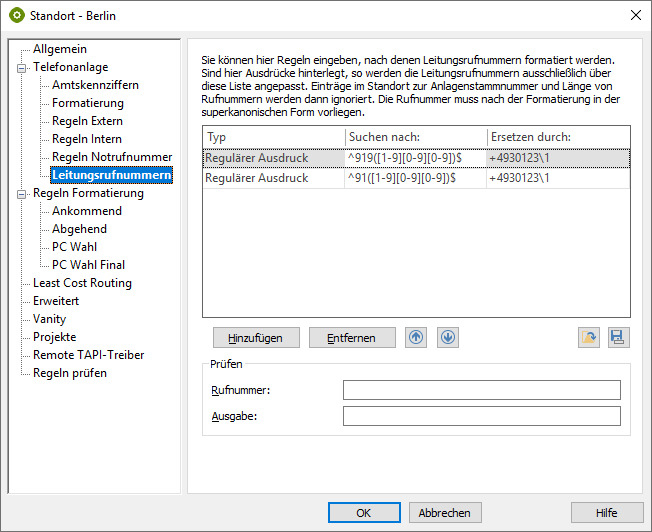
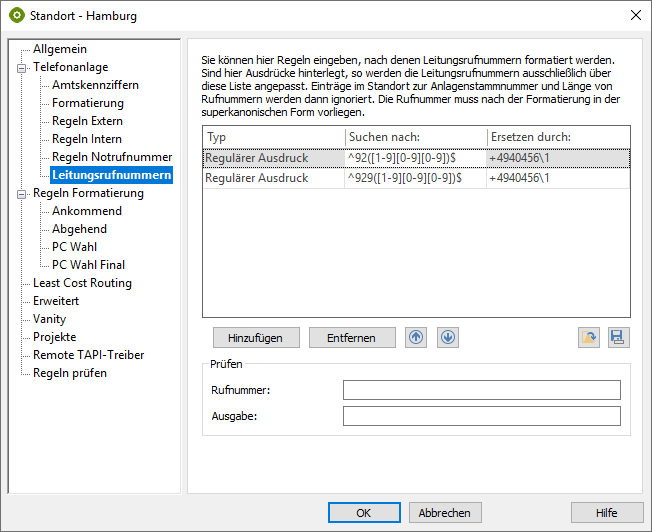
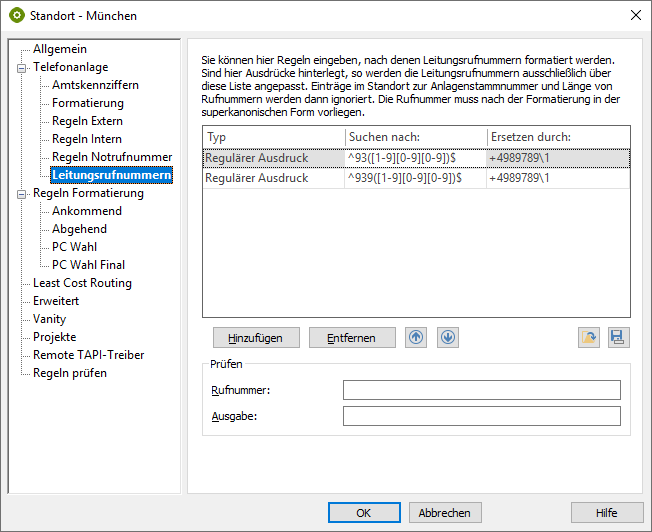
The expressions under "Telephone system >> Line numbers" are intended to ensure that the correct E.164 number is determined from the respective internal number.
It is important that only the RegEx for the phone numbers of your own location is stored.
| Berlin | Regular expression | ^([1-2][0-9][0-9])$ | +4930123\1 |
| Berlin | Regular expression | ^9([1-2][0-9][0-9])$ | +4930123\1 |
| Hamburg | Regular expression | ^([3-4][0-9][0-9])$ | +4940456\1 |
| Hamburg | Regular expression | ^9([3-4][0-9][0-9])$ | +4940456\1 |
| Munich | Regular expression | ^([5-6][0-9][0-9])$ | +4989789\1 |
| Munich | Regular expression | ^9([5-6][0-9][0-9])$ | +4989789\1 |
Formatting for outgoing dialing via ProCall
For each location, the appropriate rules for formatting must be entered in the UCServer administration under Rules formatting → PC choice via regular expressions.
Example screenshots: Location – Rules formatting – PC choice – Regular expression
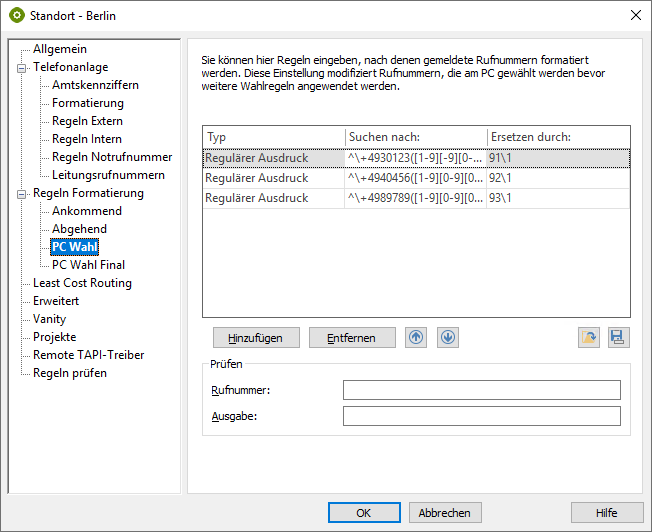
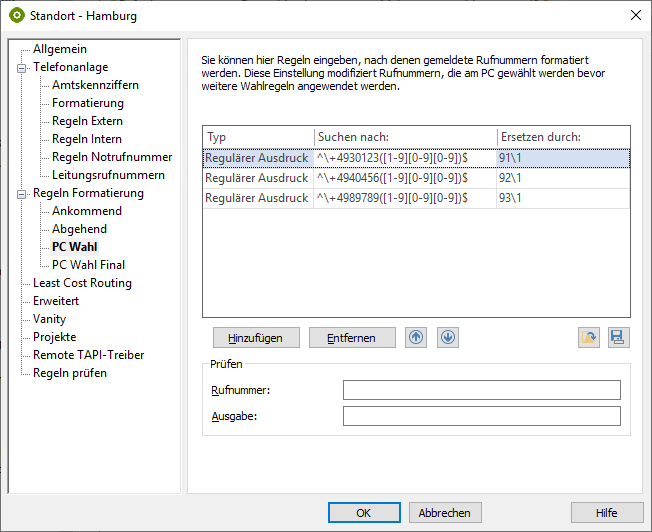
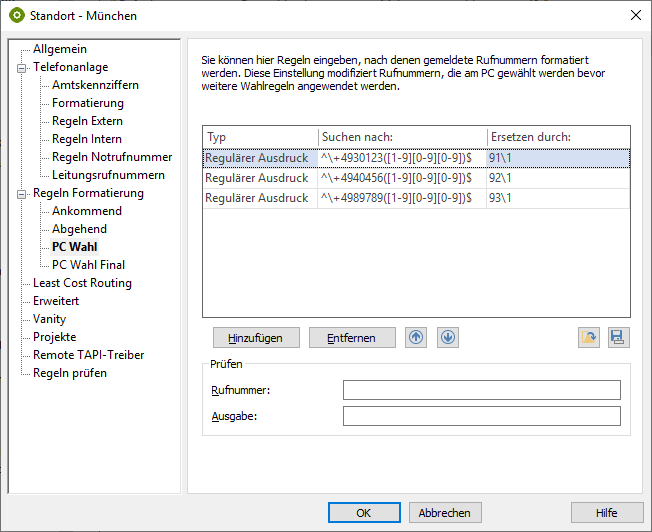
The expressions under "Telephone system >> PC dialing" are intended to ensure that the correct internal telephone number is determined from the respective E.164 telephone number.
| Type | Search for: | Replace with: | Comments |
|---|---|---|---|
| Regular expression | ^\+4930123([1-9][0-9][0-9])$ | \1 | So that colleagues in Berlin are dialed internally |
| Regular expression | ^\+4940456([1-9][0-9][0-9])$ | \1 | So that colleagues in Hamburg are dialed internally |
| Regular expression | ^\+4989789([1-9][0-9][0-9])$ | \1 | So that colleagues in Munich are dialed internally |
The phone numbers of the SIP lines (9XXX) do not need to be taken into account here, as the colleagues are always dialed via the 3-digit extension or internal phone number. The fact that the SIP line is called is solved via the PBX by call forwarding from XXX to 9XXX or by tandem, twinning or MULAP configurations, for example.
Line groups
The location of the line groups can then be set to <Automatic>.
The RegEx in the locations under "Line numbers" automatically recognizes which lines belong to which location, assigns them to the corresponding location and determines the E.164 phone numbers.
Example screenshots: Properties for line group – Location settings - Location of the group – <Automatic>
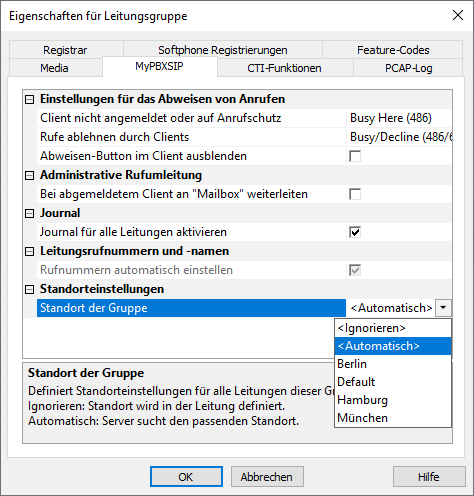
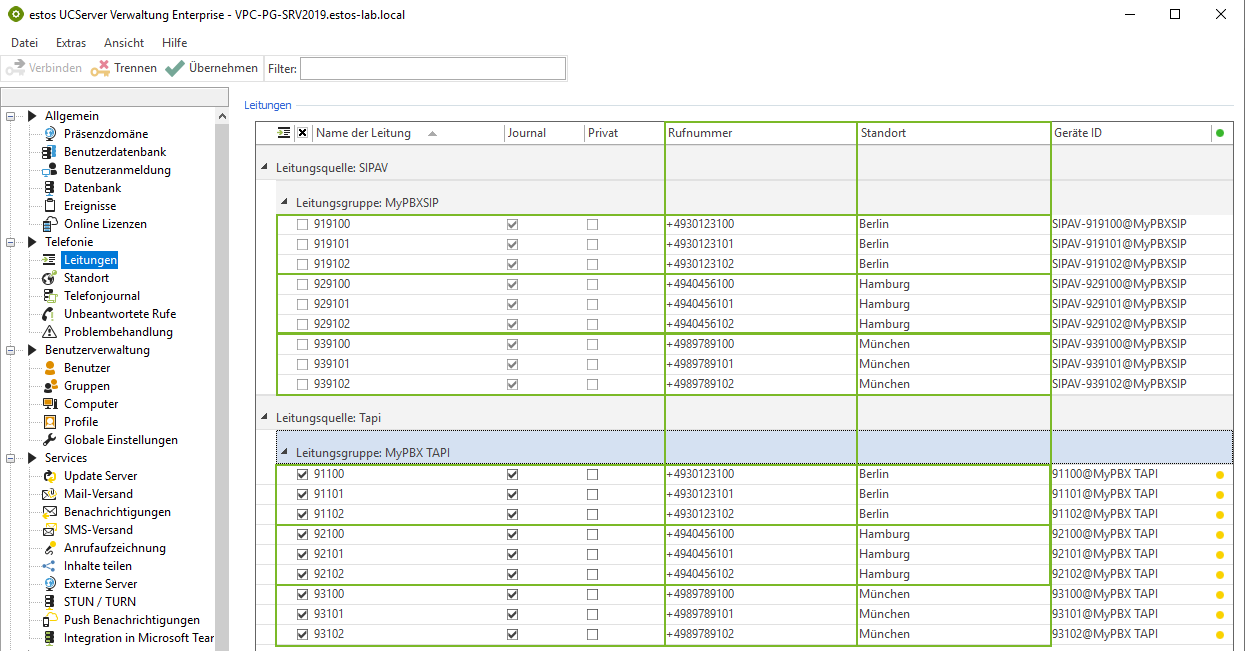
Users
To ensure that the lines are assigned automatically, the phone numbers are entered for the users in E.164 format.
Example screenshot: Settings for users – Phone numbers – Select line – Phone number
